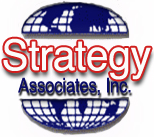
Categories of Business Excellence
“Computer power is now 8,000 times less expensive than it was 30 years ago. If we had similar progress in automotive logistics technology, today you could buy a Lexus for about $2. It would travel at the speed of sound and go about 600 miles on a thimble of gas.”
The Categories of Business Excellence used in this assessment are similar to those used to select annual winners and finalists of the Malcom Baldrige National Quality Award and the Florida Sterling Award, coupled with the European Quality Award. The result is a nine category framework consisting of sixty or so examination items that any business leader would periodically review to assess their organizations current level of performance. These items are based upon “best-practice” standards and are grouped into nine “categories of excellence” against which organizations can evaluate their progress towards world-class high-performance.
Using our Roadmap, each of the nine categories are evaluated from a three-fold perspective present in every Baldrige Assessment: approach, deployment, and results, often called the A/D/R in quality circles. In order to establish a baseline from which to measure progress, managers and supervisors, along with many staff workers, participate in interviews and data-gathering sessions. The assessment data is eventually classified into a process package for each area and compiled into the nine categories for the overall organization’s quality system as follows:
- Average Solid Max
- Leadership 30 60 110
- Strategic Planning 20 40 80
- Customer and Market Focus 25 50 80
- Information and Analysis 20 40 80
- Human Resource Development 30 60 100
- Process Management 15 30 100
- Business Results 60 120 250
- Community Responsibility 25 50 100
- Innovation and Creativity 25 50 100
- Totals 250 500 1000
Each category and respective subcategory are then scored in terms of a percentage of compliance against the standard, as shown on the scoring Guidelines found in the Technical Supplement at the end of this manual. A maximum score of 1,000 points exists, with 750+ points indicating a world-class organization having a fully developed and mature quality system.
Leadership
High performance is just too big of a change to bring about unless all three aspects of leadership are present: mental, spiritual, and physical. Many executives make the mental commitment. They think that quality is good and they say so. Some add a spiritual commitment and you can tell that they really believe in quality. However, the key is physical commitment, to put your body into the process. To take part in training and participate on teams. To get out of the office every day and give people face-to-face support and guidance. To become a “renaissance manager” by demonstrating creativity and a technological flair, as well as a deep understanding of the marketplace with its political and economic forces.
To become a “knowledge engineer,” able to grasp a problem and know what technologies are most appropriate for a specific application. To demonstrate an ability to envision your strategic intent and energize your organizational unit. To create an environment that enables your organization to succeed. To exert a positive influence beyond your organization, in your community and your profession. And above all, to let your imagination transcend conventional barriers.
Strategic Planning
Strategic Planning in the quality system environment is the process of answering a few basic business questions. What business are we in as an agency? What are our consumer’s expectations? What are our strengths and weaknesses? How do we know? How do they compare with our competition? What must we do to succeed? To excel? To be a world-class leader? Companies typically respond to these questions by focusing on their programs, products, and services, but to become a quality leader, the organization must go beyond this narrow perspective to include the total needs of the consumers.
Customer and Market Focus
This category is about how organizations provide better integration of the different methods they use to understand stakeholders and their requirements. This includes the ways that they determine satisfaction and how they stay close to their consumers, including regular customer contact as well as survey methods to determine satisfaction and enhance relationships. Managing customer relationships examines how an agency determines what will satisfy consumers. Without the firm foundation of a high-quality process for determining consumer requirements and expectations, the entire quality system can collapse.
Information and Analysis
To manage quality, you must first measure it. A quality system is built on a foundation of fact, one that measures quality and analyzes the resulting data. The following principles of management are embedded into every effective quality system: (1) Measurement must be specific and exactly what the organization wants to measure (2) Measure the programs and services that provide highest value to the consumer (3) Measures should be applied to all performance dimensions, external and internal (4) Understand the game before trying to keep score in order to avoid tracking the wrong measure (5) Measure process as well as results (6) Anticipate future process and customer requirements (7) Remember that there is no single perfect measure.
Because a quality system is based upon fact, many organizations quality systems are wobbly. According to the Baldrige Directors, this category is a national problem. The issue is that many organizations don’t measure quality, or analyze data when they do measure it. And they don’t measure progress towards their quality goals. So they can’t identify the causes of their quality problems. The problem is compounded because they don’t have a database on which to plan or evaluate improvements. The result is a lack of real-time data for use in planning, reviewing performance, improving processes, or comparing performance with potential competitors.
Human Resource Development and Management
An organizations success depends upon the knowledge, skills. and motivation of its workforce. Employee success depends increasingly upon having opportunities to learn and practice new skills. Management needs to continue to invest in the development of its staff through education, training, and opportunities for continued growth. Major challenges in the area of workforce development include the integration of human resource practices: selection, performance, recognition, training, and career advancement. The alignment of human resource management with strategic change processes such is critical. Also, the design, management, and improvement of company work processes that support company action plans and related human resource plans needs to be well developed outside of the HR Department. Addressing these challenges requires use of employee related data on knowledge, skills, satisfaction, safety, motivation, and well-being. Such data needs to be tied to indicators of agency performance, such as customer satisfaction and retention, productivity, and quality of programs and services.
Process Management
In the high-performing organizations, processes are a way of life. They are documented, flowcharted, more stable and predictable, and fairly tightly controlled by the workers on the norm. Strict process limits have been established using statistical techniques and handling breakdowns, worker inexperience, and other sources of variability have been monitored to the extent possible. Rigorous tests and audits insure that deviations, problems, and screw-ups were quickly discovered and reported. Long program and production runs build up learning and accumulated experience. The resultant operations have few breakdowns, errors, and defects that can be traced to process-related problems.
Business Results
Effectiveness is measured by results, the results of the total organizational efforts by every person in the agency. Business Results provide a results focus that encompasses the consumer’s evaluation of the agency’s programs and services, the agency’s overall financial and market performance, and the results of all key processes and process improvement activities. Through this focus, the criteria’s dual purpose– superior value of programs and offerings as viewed by consumers and superior agency performance as reflected in the operational and financial indicators– are maintained. Specifically, five results areas are covered in this category: customer satisfaction results, financial and market results, human resource results, supplier results, and agency-specific results. An organization’s performance measurements need to focus on key results areas.
Prevention is a characteristic of an excellent quality system, rather than fire-fighting. Agency-specific results also call for reporting quality levels and improvements for the program and service attributes that truly matter to consumers and the marketplace. The correlation between quality and productivity indicators is a critical management tool for focusing on key attributers that best reflect agency performance, as well as anticipating changes in the marketplace, or in the attributes themselves. This category includes the results achieved from improvements in the key indicators of supplier (provider) quality. Even organizations that measure enough parameters often do not have enough data points to show the direction of trends, which usually require at least 3 to 5 years of data.
Community Responsibility
Becoming a high performance organization takes more than having the right financial and customer satisfaction results and having the right systems in place. You also have to learn to be a good corporate citizen. This is about developing plans and implementing activities directly relating to corporate citizenship and public responsibility. It means factors such as environmental protection, legal, ethical, and regulatory responsibilities.
Being a good corporate citizen relates to how the organization sets goals and standards relating to societal responsibility. The best companies are those that anticipate future public concerns about their products and services and deal with those issues in a preventative fashion–about looking into the future to spot trends that may impact the organization, and about planning for those trends. It is also about how the organization promotes ethical and legal conduct in all that it does. It is also about what the organization is doing to encourage their employees to strengthen their communities. It is about what the employees are doing to demonstrate good citizenship and involvement in the communities of the world in which the organization operates. It is also about helping other organizations in their quality improvement efforts.
Innovation and Creativity
Creativity is the bringing into existence a new idea, while innovation is the practical application of creative ideas. In other words, making money from creativity. Most people are born with the ability to think creatively, providing that the set of skills is learned, developed, and utilized in daily problem solving. Helping people develop these creative skills so that innovation can occur is the job of the high-performance organization.
There are basically four types of innovation that organizations involved in pursuing high-performance strategies need to be concerned about: product, process, marketing, and management. These four types are coupled with some forty-nine characteristics that an organization’s culture needs to possess to achieve strategic competitive advantage through innovation and adaptive learning. Product innovation results in new products or services, along with enhancements to existing ones. Process innovation results in improved processes within the organization’s supply chain, thereby focusing on improving the efficiency and effectiveness of logistics processes. Marketing innovation is related to the marketing functions of promotion, price, distribution, and product-related packaging. Finally, management innovation improves the way the organization is managed.
Product innovation leads principally to competitive advantage through differentiation, while process innovation leads to a low-cost advantage. In most world-class organizations, product and process innovation are coordinated. Marketing innovation helps achieve relative differentiation and relative low-cost objectives by improving strategies and tactics concerned with the marketing mix. In an age where the consumer is bombarded by advertisements, innovative marketing techniques are crucial to successful sales. In many cases, real differentiation and lower cost don’t matter if the customer perceptions are not in line. Marketing innovation helps align the desired perceptions by building strong relationships with customers so that the key marketing mix variables are strengthened–which are product, promotion, price, distribution, and target market. There are four questionnaires that an organization can use to measure its performance in this area–its Innovation Quotient (IQ).
As previously mentioned, various assessment instruments are available to evaluate the organizations current situation relative to each of these nine Categories of Business Excellence.
